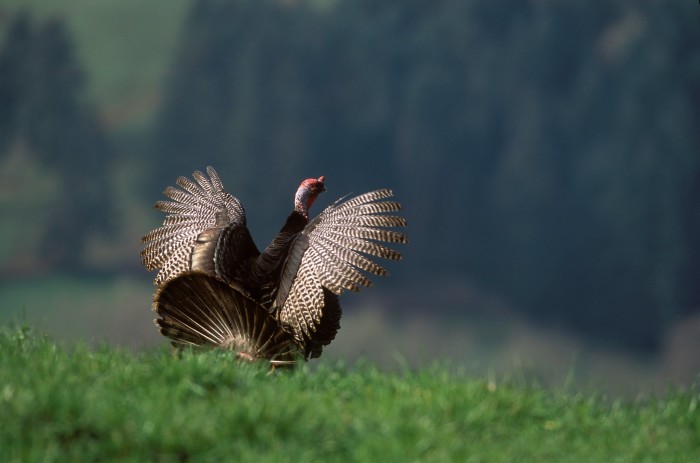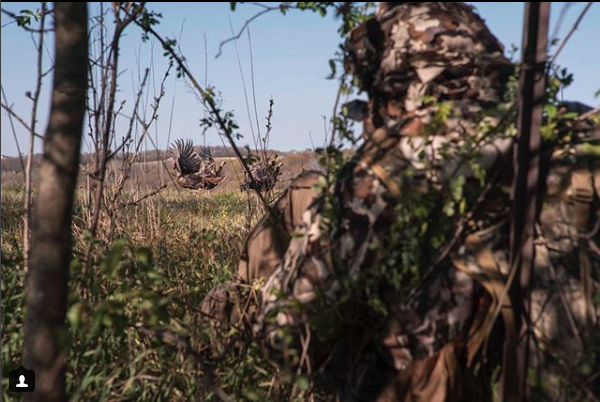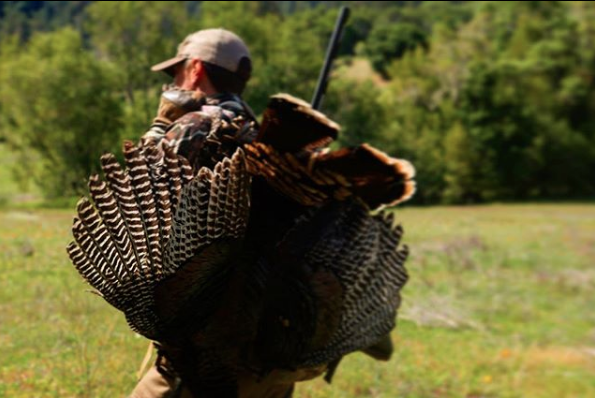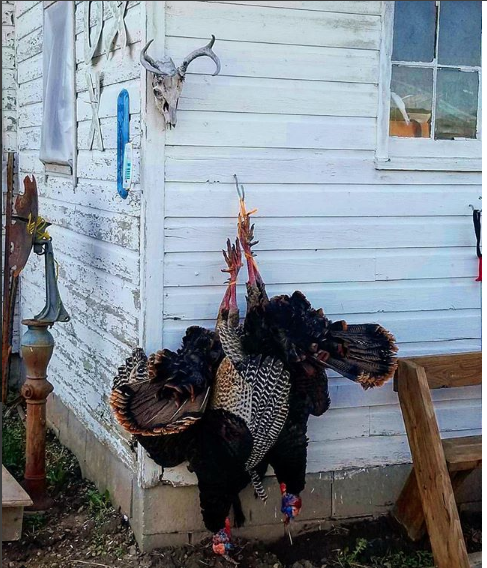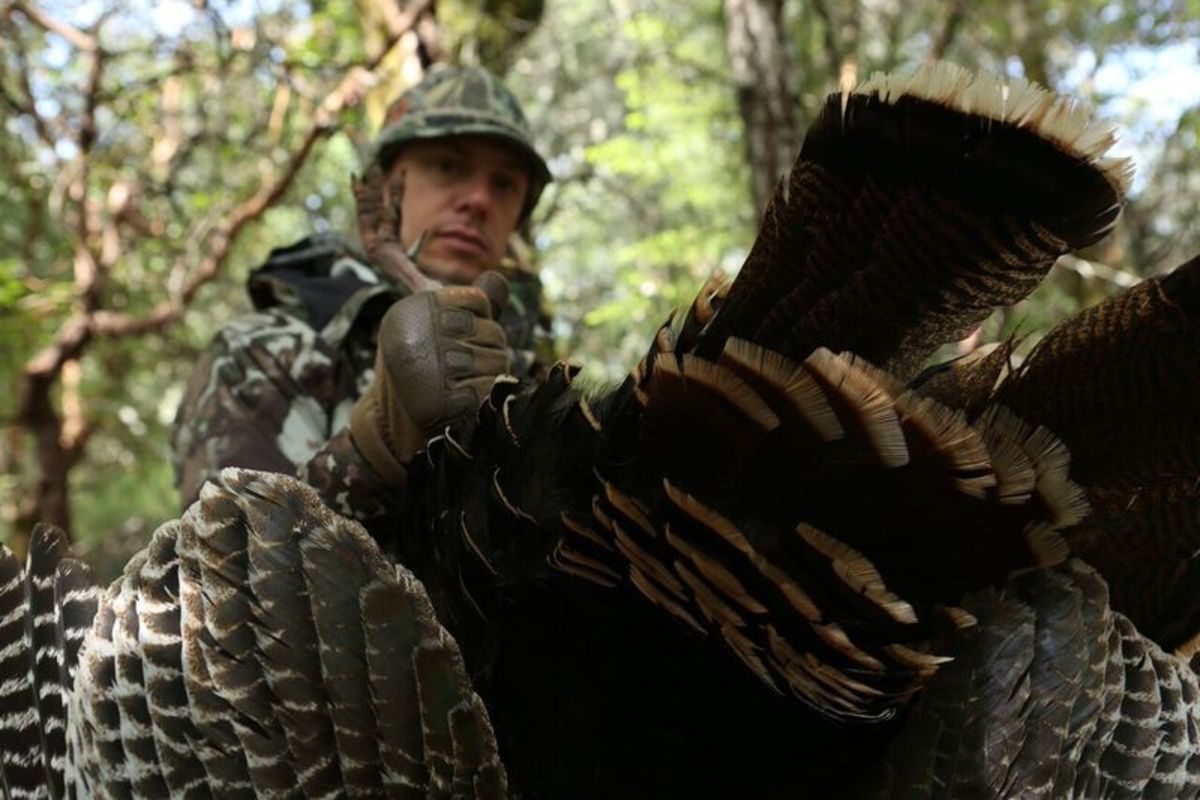
Hunting wild turkeys is both maddening and addictive. Once you’ve got the turkey hunting bug, you’ll happily suffer through day after day of matching wits with giant, paranoid birds that often seem impossible to kill. Due to the inherent challenges of pursuing wild turkeys, hunters have come up with a lot of ways to fool them. During both spring and fall seasons, turkey hunting styles can range from quiet and stealthy to loud and aggressive. Some of these techniques are well-known and well-accepted while others are unconventional and even illegal in some states.
Calling
Conventional thinking has it that a spring turkey hunter heads out to the turkey woods well before dawn. There he or she will listen for a gobbler sounding off from his roost. Next, the idea is to sneak undetected to within a hundred yards or so of the gobbler, sit silently against a thick tree trunk, and wait for first light. When the sun rises and the gobbler gobbles, the hunter makes a few soft hen yelps with a mouth, box, or pot call. Then that gobbler will fly down out of his roost tree, walk towards the sound of the call searching for a hen, strut around, and promptly get shot.
The truth is that calling in spring gobblers rarely works this easily. This is because coaxing a male turkey into shotgun or bow range by making noises that mimic the sounds of hen turkeys is the opposite of how things usually work in nature. In fact, it’s the hens that actually go to the gobbler and he knows this. That’s why it can be so very difficult to fool a gobbler into going against his nature by seeking out the source of a hunter’s hen calls. For this reason, calling in a wise old tom is considered the pinnacle of turkey hunting. It takes practice, patience, and nerves of steel. Without a doubt, it is the most exciting, challenging, and rewarding method of turkey hunting.
Decoying
Turkey decoys are often used in conjunction with calling. Many turkey hunters who employ the use of decoys like to think it was their sweet calling notes that pulled in a gobbler but it’s more likely the calling merely tipped the gobbler off to the location of the decoy, which did the hard work of convincing the bird to close the distance.
That’s because decoys appeal to a spring gobbler’s strongest urges, which are to breed and to fight other gobblers. A horny or belligerent gobbler will often close in on a decoy at a full run. And decoys can pull even the most wary, call-shy, public land birds right in to your lap. But decoys don’t always work. If a gobbler sees a hen decoy that shows no signs of approaching him, he may just walk away. And a gobbler who has been beat up a few times by more dominant males will often run away if he sees a big full-strut tom decoy.
Decoy setups can range from a single, inexpensive, packable hen to a spread of ultra-realistic hens, jakes, and strutting gobblers that can add up to hundreds of dollars. When I use a decoy, it’s a collapsible plastic jake with a slit I cut into the rear which holds a real gobbler’s tail fan. It’s pulled in dominant gobblers and gangs of jakes looking to thrash a loner.
Ambushing or Stand Hunting
Ambushing turkeys works for well for hunters who have the patience to wait for the birds to come to them. Some preseason scouting will reveal the established travel routes that turkeys are using routinely. Generally speaking, turkeys are creatures of habit and they’ll use the same roosting, feeding, and loafing areas over and over as long they’re not being disturbed. By studying these patterns, a hunter can plan an ambush or stand location that will put a turkey in range.
Find an area with good natural concealment or build a blind along travel routes or feeding locations. One the best places and times to ambush turkeys is at their roost site in the evening. (This is not an option in states where spring gobbler hunting hours end around lunchtime). Ambushing combined with periodic calling works well during spring gobbler seasons and during fall seasons when large flocks of birds are hitting waste-grain crop fields on a regular basis.
Spot and Stalk or Bushwhacking
Bushwhacking is a term some hunters use for spot and stalk turkey hunting. First, a hunter glasses up a distant gobbler or group of turkeys and then he or she will sneak into shooting range using topography and vegetation to stay out of sight. Bushwhacking is a more common tactic in the more open expanses of the West but it can be used anywhere a hunter can slip in close enough to get a shot on a turkey. Irrigation ditches, brushy fence rows, and creek beds make for stealthy bushwhacking routes.
Some died-in-the-wool turkey callers consider bushwhacking the lowest form of turkey hunting. I prefer calling turkeys but I bushwhacked my first couple of spring gobblers because I had no confidence in my calling skills and a lot of confidence in my big game stalking skills. But after getting busted several times before successfully sneaking up on a gobbler, I learned bushwhacking ain’t easy. I’ve had gobblers several hundred yards away bolt at the slightest movement on my part. Wild turkeys have incredibly good vision and they are always alert to the point of paranoia. So if you can creep up one and kill him, you’ve got some serious stalking skills. Where it can be done safely, bushwhacking can work well during spring and fall turkey seasons.
But there are some considerations to make before attempting to bushwhack a turkey. First, it may not even be legal. For instance, in Pennsylvania, actively stalking turkeys is against the law. This is because there is some amount of risk involved since you could be stalking a turkey that another hunter happens to be working. And even if it is legal, you should be very cautious before planning a stalk on a bird, especially on public land. It should never be attempted in thick cover and hunters should never “stalk” turkey noises that they hear made by birds they can’t see. You could be sneaking in on a hunter’s calls instead of a wild turkey.
Flock Busting
The first wild turkey I ever killed was a jake that flushed out from under a thick wad of wild grape vines. This happened on a mixed bag small game hunt when my buddy and I unknowingly walked into the middle of a flock of turkeys that spooked and flew away noisily. We weren’t even hunting turkeys but we had busted up a flock which scattered the birds in every direction and that lone jake headed for cover. Later, hoping to flush a rabbit or ruffed grouse, I kicked that clump of grape vines and out flew my first turkey.
Busting up flocks is a common hunting technique used during fall turkey seasons and I know one hunter who used the tactic successfully on an early spring season hunt when turkeys were still bunched up in a large winter flock. The idea is to find a flock of turkeys and get close enough to them to rush in, spook them, and scatter them in different directions. Once the birds have been scattered, individual turkeys have a strong desire to reunite with their flock which makes them vulnerable. If a hunter sits down and calls from the spot where the flock was scattered, turkeys will often return fairly quickly to the area to join up with their buddies.
In many states, it is legal to use dogs to bust up a flock of birds during fall turkey seasons First, the dog does the hard work of finding the turkeys the same way upland bird hunting dogs sniff out quail or grouse. Then the dog will rush in and flush the flock. A fast-moving dog will scatter the birds in every direction more effectively than a hunter could. Then the hunter can call the confused and lost turkeys back in. Dogs can also be useful for finding crippled birds.
I haven’t hunted turkeys over dogs but they must smell the same as other upland birds because my springer spaniel has flushed turkeys on grouse hunts in Colorado and pheasant hunts in Nebraska. One of these days, I’ll have a fall turkey tag in my pocket when that happens.
Fanning or Reaping
Finally, we’ve got fanning or “reaping” turkeys. Fanning a gobbler involves first finding one that’s strutting in a mating display out in an open field. Then a hunter closes the distance to the gobbler while crawling and hiding behind a real or artificial tail fan. Often when a dominant gobbler see this tail fan approaching, they see only a strutting rival and throw all caution to the wind, making a beeline to challenge the interloper. Gobblers are often shot at distances of only a few yards. They don’t even seem to notice the hunter, only the tail fan that signals a challenger moving into their mating grounds. And when you see reaping work, those wise, old gobblers that are all but impossible to call in start to look pretty damn gullible.
Reaping has become so popular in recent years that there are companies out there that make rigs for mounting an artificial tail fan with a see-through aiming window to your shotgun or bow. Even though reaping has some die-hard devotees, it also has a lot of hard-core detractors in the turkey hunting community. This is partially because it cheats the system; the difficult, traditional process of calling a mature gobbler into shooting range is completely unnecessary for “reapers”. But mostly it’s controversial because reaping is inherently dangerous. And regardless of your ethical take on reaping, the danger is certainly not to be understated. Creeping around during spring gobbler season with a turkey tail fan in front of your face is a risky move. The only way to minimize that risk is if you are hunting on private property where there’s no chance of another hunter mistaking you for the real thing. If you use this turkey hunting technique on public land, you’re begging to get shot in the face. Accidental shootings have even occurred on private land with hunters from the same party.
Personally, reaping is not something I’m dying to try. I’m looking forward to early spring mornings and calling to gobbling birds. Hopefully, I’ll lure a big tom into range with some sweet hen talk.

